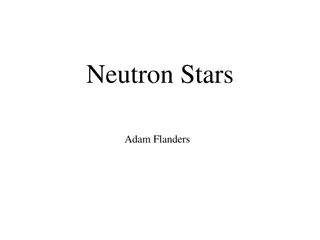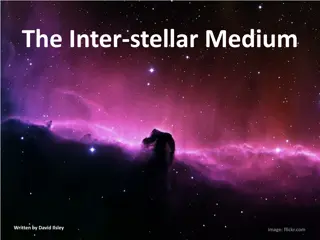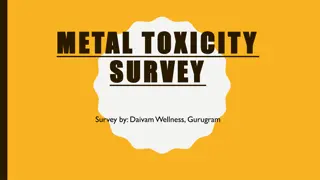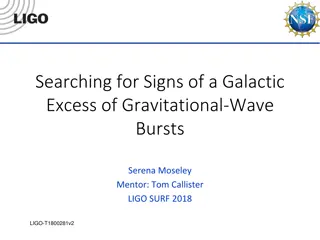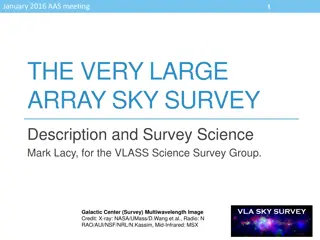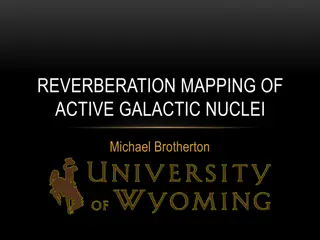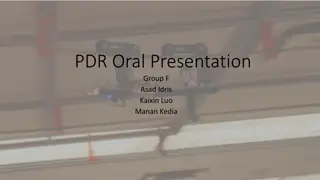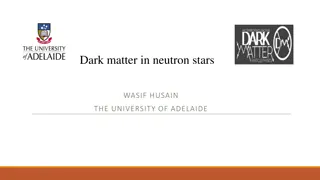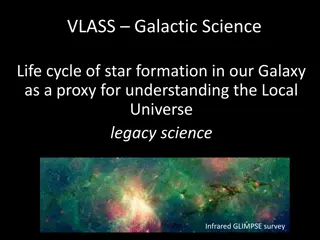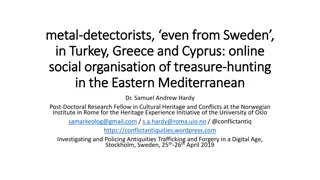Metal-Rich Field RR Lyrae Stars and Galactic Evolution
Metal-rich field RR Lyrae (RRab) stars, distinct from cluster RR Lyrae stars, play a significant role in Galactic evolution due to their unique characteristics. With periods around 0.4 to 1 day, these old stars with sawtooth light curves are found to have a disk-like distribution and kinematics. Their importance lies in potentially challenging our current understanding of the age and assembly of the Galactic disk. The mystery surrounding these stars continues to fuel research into their role in shaping the Milky Way.
Download Presentation

Please find below an Image/Link to download the presentation.
The content on the website is provided AS IS for your information and personal use only. It may not be sold, licensed, or shared on other websites without obtaining consent from the author.If you encounter any issues during the download, it is possible that the publisher has removed the file from their server.
You are allowed to download the files provided on this website for personal or commercial use, subject to the condition that they are used lawfully. All files are the property of their respective owners.
The content on the website is provided AS IS for your information and personal use only. It may not be sold, licensed, or shared on other websites without obtaining consent from the author.
E N D
Presentation Transcript
Disk RR Lyrae stars Ken Freeman, Heather Morrison, Yichen Lin ANU CWRU ANU KCF@80 20 Sep 2022
RRab variable stars are old stars (> 10 Gyr) with periods of about 0.4 to 1 day and sawtooth light curves that are easily recognised. They are found in globular clusters and in the field. Most of the field RR Lyr stars are metal-poor halo stars with [Fe/H < -1.0 There is a component of metal-rich field RR Lyr stars ([Fe/H] > -1.0) : they have a disk-like distribution and disk-like kinematics. This has been known for decades. George Preston (1959, 1964) showed that the metal-rich field RRab stars have periods < 0.d44, and low solar motion and random velocities relative to the Galactic rotation. He associated them with the Galactic disk.
Most of the RRab stars are halo stars many are clustered around V= 0 in the accreted Gaia-Enceladus sausage structure. The metal-rich RRab stars have disk kinematics - very different from the halo.
These metal-rich field RRab Lyr stars are not like the RRab Lyr stars in the more metal-rich globular clusters. They have much shorter periods than the cluster RR Lyr stars of similar metallicities. These stars are something else Chadid et al (2017) described them as sui generis - i.e. of their own kind what they are is not really understood yet but they are potentially important for Galactic evolution in several ways.
cluster RR Lyr The metal-rich disk RR Lyr stars have shorter periods than cluster RR Lyr of similar metallicity Chadid, Sneden, Preston 2017
Why are the metal-rich field RR Lyr stars important ? RR Lyr stars are believed to be older than 10 Gyr (from their incidence in star clusters of various ages). If they are part of the Galactic thick disk, then that is not a problem: the thick disk is believed to be 10-12 Gyr old. If they are part of the Galactic thin disk, then there is a problem: the thin disk would then be older than we currently believe (~ 8-9 Gyr), and our ideas about the assembly of the disk may need revision. Martin & Morrison (1998) derived 3D UVW stellar motions for 130 nearby RR Lyr field stars. The stars with [Fe/H] < -1.0 were clearly kinematically much colder (more disk-like) than the more metal-poor stars. With the astrometric precision available at the time, it was not clear whether these stars are thick disk stars or a mixture of thin and thick disk stars.
To derive precise stellar motions, precise distances and proper motions are needed. Gaia data became available in DR2 (2018) and DR3 (2022), and new motions have been derived for RR Lyr stars (this project, Prudil et al 2020, Iorio & Belokurov (2021) . ), with some emphasis on understanding the nature of these metal-rich RRL stars. We also need precise metallicities and radial velocities to establish the nature of the disk RRL stars. These have gradually become available from high resolution ground-based spectroscopy (e.g. Crestani et al 2021) and from the Gaia RVS in DR3 (for radial velocities).
For this project, we assembled data for a sample of 128 RRab stars within 4 kpc of the sun, all with high resolution spectroscopic abundances, accurate radial velocities from several sources, and Gaia DR3 parallaxes and proper motions. The Gaia DR3 parallaxes were corrected for the DR3 parallax bias. The (R, z) cylindrical Galactocentric velocities have a precision ~ 3 km/s in each component. Metallicity data come from a compilation of high resolution [Fe/H] and [ Fe] by Crestani et al (2021) : typical errors ~ 0.1 dex. Now look at how the RRL (R, z) velocities depend on metallicity
Vz halo thick thin The RRL in the thin disk abundance range [Fe/H] > -0.5 have a z-velocity dispersion z = 16.7 km/s, similar to corresponding non-variable thin disk stars. All of the RRL in the thick disk abundance range [Fe/H] = -0.9 to -0.5 have negative velocities (?)
V The dispersion and rotational lag of the disk RRL stars ([Fe/H] > -0.9) increases as the mean [Fe/H] decreases. The nearby halo is dominated by the low angular-momentum Gaia-Enceladus- Sausage structure near V =
VR The RR Lyr stars follow approximately the increase in velocity dispersion of the non-variable stars, as the [Fe/H] values decrease from values typical of the thin disk to thick disk to the metal-poor halo.
Summary of velocity dispersions for disk RR Lyr stars and non-variables R (km/s) z Non-variable old THIN disk stars (GCS) [Fe/H] -0.5, 6 < age < 10 Gyr 42 1 28 1 23 1 RR Lyr stars (this project) [Fe/H] -0.5 34 6 27 4 17 3 Non-variable THICK disk stars (GCS) -0.9 [Fe/H] < -0.5, age > 10 Gyr 66 4 51 3 35 7 RR Lyr stars (this project) -0.9 [Fe/H] < -0.5 55 11 43 8 32 4 GCS = Geneva-Copenhagen survey (Casagrande et al 2011)
[Fe] vs [Fe/H] Halo 0 [ Fe] vs [Fe/H] for thin disk, thick disk, halo stars elements here are Mg, Si, Ca, Ti (Helmi et al 2018) : ([ Fe] is indicator of past star formation history and star formation rates). The RR Lyr stars show a similar trend.
The RR Lyr stars in our sample show a similar [Fe] trend to the nonvariable disk and halo stars
The disk RR Lyr stars are in the same [/Fe] range as the nonvariable disk stars
Origins and Conclusion There is a thin disk component of metal-rich RR Lyr stars near the sun. The kinematics and [ Fe] vs [Fe/H] relation for the disk RR Lyr stars appear similar to those for the non-variable disk stars. The oldest non-variable stars in the thin disk are currently believed to be ~ 1-2 Gyr younger (8-9 Gyr) than the RR Lyrae stars (10 Gyr +). If the progenitors of the disk RR Lyr stars were born in the thin disk, then the age of the thin disk probably exceeds 10 Gyr.
Or did they migrate from the inner Galaxy, where there is a large population of RRL stars covering a similar range of [Fe/H] ? (Radial migration of these stars could generate a cold sub-population of disk RR Lyr stars near the sun). MDF for RR Lyr stars in inner 4 kpc of the Galaxy (Fourier 31abundances) Pietrukowicz et al 2015
Or did these sui generis RR Lyr stars become RR Lyr stars by a different evolutionary route: e.g. via mass exchange in a binary system as suggested by Bono et al (1997) and others. Then they could be much younger than 10 Gyr. Binary mass transfer scenario: expect these RR Lyr stars to have orbital periods ~ 1000 - 2000 days orbital velocities ~ 4 7 km/s (Bobrick et al 2022)
Each point shows the phase- corrected systemic velocity. Epoch color-coded as in figure below. Vertical bar shows 10 km/sec
CONCLUSIONS 1. There is a metal-rich population of RRab stars with thin disk kinematics 2. If they were born in the Galactic thin disk, and are as old as other RRab stars, then the thin disk is at least 10 Gyr old. Alternatively . 3. They could be much younger stars, formed via binary mass transfer, but this seems unlikely we find metal rich RRab stars with no significant long- term velocity variations. 4. They may have migrated from the inner Galaxy, where metal-rich RRab stars are common.
Estimates of the binary properties at the present time indicate periods ~ 1000 d and long-term velocity variability ~ 10 km/sec. We were given access to long velocity time series for a sample of metal-rich RR Lyr stars, and there is no evidence for such long-term velocity variability.










